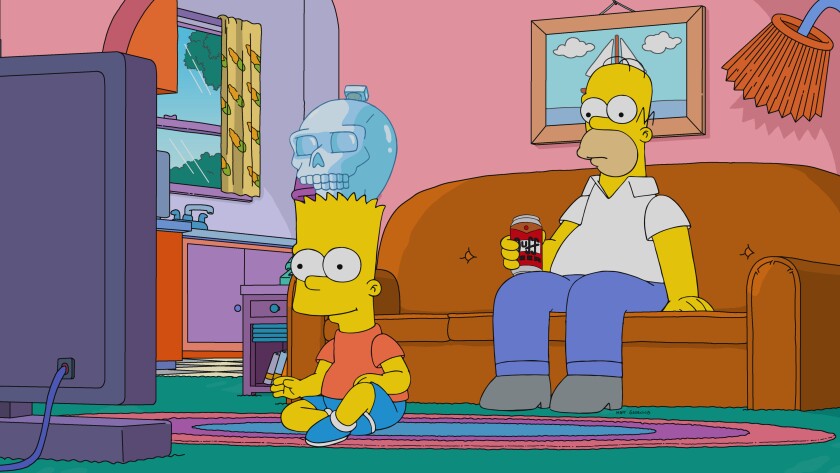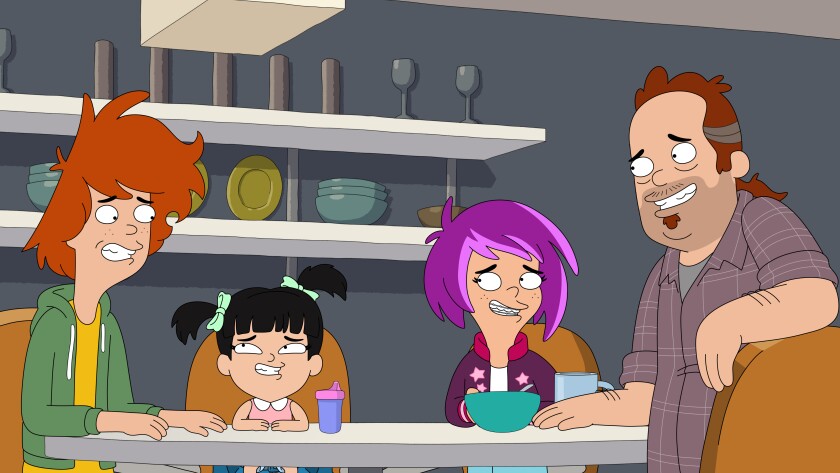
‘The Simpsons’ is not the only cartoon to revolutionize the sitcom
Among the not-all-that-many new series premiering this second pandemic fall television season is Paramount+’s lively “The Harper House,” a situation comedy starring Rhea Seehorn. It’s about a family that, having lost its main source of income — the mother’s job — moves from the richer side of town into a fortuitously inherited property on the poorer side. That’s not an unfamiliar premise in the history of television, but what sets “The Harper House” apart is that it is a cartoon.
At the same time, “The Harper House,” created by Brad Neely (“China, IL”), is only the latest of a long-growing body of animated family sitcoms — sitcoms about, not always for, families — that might easily have been developed as live-action shows: cartoons set within a recognizable ordinary world, without talking animals or magical beings, among mostly related people who live together, their neighbors, friends and associates; cartoons where the connections between the characters mean as much, or more, than whatever satirical or topical or slapstick ends the show might also serve.
You can go back, prehistorically, to Hanna-Barbera’s “The Flintstones,” the “modern Stone Age family” comedy, which premiered in 1960 on ABC. Viewers would have recognized it as modeled on Jackie Gleason’s “The Honeymooners,” which had gone off the air only four years before; it was followed in 1962 by the future-set “The Jetsons,” which had as its model something like “The Donna Reed Show,” for its family demographics, with a touch of “Hazel,” for its robot maid.
But the first straight-ahead, contemporary cartoon sitcom, also from Hanna-Barbera, is 1972’s “Wait Till Your Father Gets Home,” a generation-gap comedy with Tom Bosley (soon to play Richie Cunningham’s father on “Happy Days”) as a man unable to make sense of his children. The humor can be a little dated — although Jack Burns’ conspiracy-minded racist neighbor feels unsettlingly current — but the design, with watercolor furnishings floating on bright fields of color, is bold and still fresh. Its structure is that of a single-camera sitcom; indeed, its pilot script, first realized in animated form as a segment on “Love, American Style,” also was filmed in a live-action version, starring Van Johnson.

A scene from “The Simpsons,” the foremost animated family sitcom of them all.
(20th Television)
Above all, there is “The Simpsons,” which came along 17 years later, the first prime-time animated show since “Wait” to center on a more or less ordinary human family. Satire was always a point of the show, but the fact that the family was tied together by something more than expediency, something that might on a good day be called love, was key to its success. (Matt Groening might have had a comic strip called “Life in Hell,” but co-developer James L. Brooks co-created “Taxi” and directed “Terms of Endearment.”) Argue all you like about which of its 32 seasons are better or worse, but the fact that you are arguing at all is only proof that you care, and when the last iceberg melts into the sea and waves are licking the base of the Hollywood sign, “The Simpsons” may well still be in production, mocking whatever foolish humans remain.
Its success established a Sunday night beachhead for animation on Fox, a programming block that has been home to at least two other family-sitcom classics, “King of the Hill,” from Mike Judge and Greg Daniels, and “Bob’s Burgers,” from Loren Bouchard, along with Seth MacFarlane’s popular, low-road “The Family Guy” and its spinoffs “American Dad!” and “The Cleveland Show.”
Emily Spivey’s North Carolina-set, Kristen Wiig-led “Bless the Harts,” a sort of Southern-fried “King of the Hill,” has recently left the Fox lineup, but two fine family-themed series are keeping on: Nick Offerman stars as a Nick Offerman type with growing and adult children in the Alaska-set “The Great North,” also created by Bouchard; and with “Simpsons” vets Mike and Julie Scully, his “Parks and Recreation” co-star Amy Poehler, created “Duncanville.” It has the look and feel of a more naturalistic “Simpsons,” with the love foregrounded and no real premise beyond its characters trying to adapt to a world that is moving by or moving toward them. It has the heart and chirpy irony one would expect from a Poehler project and is, on balance, lovely.
Why are these shows cartoons? It would be simple to reboot “King of the Hill” as a live-action production, to locate actors who resembled their animated counterparts, to re-create the Hills’ house in perfect detail and proportion. And still something would be lost. Mike Judge’s art (he also created “Beavis and Butt-head”) is something less than elegant; some of his characters seem to lack … anatomy, to be held up only by the ink they’re rendered in. But the awkwardness echoes characters who are themselves awkward, often confused by the world or reaching for something beyond their grasp. It’s impossible to imagine a live version of Bobby Hill better than the animated one — and, of course, he couldn’t be played by Pamela Adlon.

The Casagrandes family and friends gather in “The Casagrandes.”
(Nickelodeon)
A revival of that series, taking up the action 15 years later, was announced earlier this year, as was one for Disney’s great and beautifully designed “The Proud Family,” “The Proud Family: Louder and Prouder.” One of the relatively few shows built around Black characters — here, the otherwise familiar complement of childish father, sensible mother, teenage protagonist, amusing babies and a dour grandmother whose hair matches her poodle — it’s once again being run by animator Bruce W. Smith, who co-directed Matthew Cherry’s Oscar-winning short “Hair Love,” which itself is being developed as a series by HBO Max, “Young Love.” Also coming back is the highly satirical Black black comedy “The Boondocks,” returned to the control of creator Aaron McGruder.
Where most every sitcom or drama looks more or less like most every other sitcom or drama, every cartoon has its own way of picturing the world. (Some may belong to an extended visual universe, as “Futurama” and “Disenchanted” do with “The Simpsons,” all derived from Groening’s peculiar way of drawing.) Places, people and things are defined by the thickness or thinness of line (if there’s line at all), its sketchiness or assertiveness, by color and the intensity of color, the painterliness of their backgrounds, and by their historical and contemporary relation to other cartoons. It’s an extra layer of expression. The comic-strip look of Nickelodeon’s “The Loud House,” its characters’ big heads and big eyes, signals that wackiness is afoot, and that it’s a show mostly about kids (and made for kids); the browns, oranges and greens that dominate its Latinx spinoff, “The Casagrandes,” suggest Mexican ceramics and a certain cultural seriousness the series bears out. “The Boondocks” looks toward anime for a heroic look.
Drawing also makes the characters one with their universe; the look of the Simpsons or the Harpers or Hills is also the look of their home, their street. One noticeable advantage of cartoon settings is that they’re less aspirational than their live-action counterparts. They better reflect the circumstances of the people who live there, who tend to have working- to middle-class jobs — propane salesman, plumber, meter maid, nuclear plant layabout — and aren’t deformed by a set designer’s taste in cool stuff or because it’s easier to shoot in big rooms. Without being “real,” they can be exactly right. You could write a paper on what’s on the kitchen counters.
You can stage elaborate set pieces without adding to the budget; your carefully drawn version of a rock festival or the Texas state Boggle championship, to point out just a couple of things I’ve seen lately, is likelier to feel closer to the real thing than the underpopulated version a live-action TV show might allow. You can set your series in New York’s Central Park if you want, as Bouchard and collaborators Josh Gad and Nora Smith did for the Apple TV+ series “Central Park,” and fill it with elaborate musical numbers. And you can go small, cutting away for five seconds for the sake of a joke. Cartoons have their own whipsaw rhythms — occasionally but rarely adopted for live-action, as in “30 Rock” or “Ned’s Declassified School Survival Guide” or even “Seinfeld” — and can pack in a lot of information without seeming rushed. (Many, of course, tell complete stories in an 11-minute episode.)

A scene from “Duncanville,” co-created by Amy Poehler.
(20th Television / Universal Television / Fox Media )
There are other practical advantages. As in the olden days of radio, casting is unrelated to physical type, age or even gender. Tall actors may play short people, young actors may impersonate seniors, plain people may play beautiful ones; it’s fluidity nonpareil. On “Central Park,” Tituss Burgess plays a child. On “Bob’s Burgers,” mother Linda and daughter Tina are played, respectively, by John Roberts and Dan Mintz; Regina King voiced brothers Riley and Huey on “The Boondocks”; and on “Duncanville,” Poehler voices both mother Anne and teenage son Duncan. And no one has to spend a minute in the makeup chair.
You can get away with things in a cartoon you couldn’t in a live-action series, or that at least would register differently. In the opening episode of “The Harper House,” there are a couple of desiccated corpses, drunk driving (with a police pursuit) and a father willing to wreck his neighbors’ marriage in order to obtain a pair of thrift-store sweatpants he has convinced himself would make the perfect birthday gift for his wife. It is hard to imagine Bill Burr’s profane 1970s serial period piece “F Is for Family,” on Netflix — a show that runs long on humiliation, trauma, shouting and a very real sort of violence — coming off as funny or ultimately sweet as it does if it weren’t a cartoon. In early episodes of “The Simpsons,” Homer would grab Bart by the throat and squeeze; try that with live actors and wait for the tweets.
Cartoons have been making steady inroads in television for a good 30 years, but with the growth of streaming services, animated fare is part of the menu any full-service TV platform must provide; both Netflix and Hulu have “Adult Animation” among their primary categories. You have generations of viewers who were raised on them, as well as growing numbers of trained animators, and animation houses, and increasing intellectual support: With the much-discussed success of series like “Bojack Horseman,” critics who might never have looked twice at a cartoon — or even once — are putting them in their Top Whatever lists. Above all, they’re often very funny, written as well as anything on television and especially nice to look at. They’re cartoons! We love them.
Stay connected with us on social media platform for instant update click here to join our Twitter, & Facebook
We are now on Telegram. Click here to join our channel (@TechiUpdate) and stay updated with the latest Technology headlines.
For all the latest Entertainment News Click Here
For the latest news and updates, follow us on Google News.

